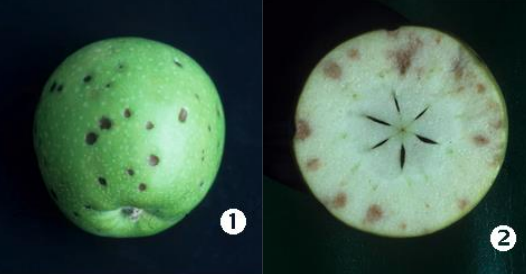Bitter pit
- Bitter pit is a disorder in apple fruits, now believed to be induced by calcium deficiency. It occurs less commonly in pears.
Symptoms
- The affected fruit have dark spots, about ½ cm diameter, which occur on the skin or in the flesh or both.
- The cells in the spots are dead (necrotic), and turn brown-black.

Causes
- Early reports indicated that the disorder was affected by climate and growing conditions.
- Dry weather before harvest seemed to increase the condition.
- Light crops, heavy use of fertilizers, large fruit and early harvesting increased the condition.
- Fruit that was free of bitter pit at harvest were often severely affected after a short period of storage.
Control
- Correct feeding and watering to maintain steady growth throughout the growing season is the key to reducing problems with bitter pit.
- Use a general-purpose, balanced fertilizer and avoid excessive feeding with nitrogenous (such as sulphate of ammonia) or potassium-rich (such as sulphate of potash) fertilizers
- Install irrigation to maintain a uniform supply of water throughout dry periods and mulch to retain moisture in the soil around the tree
- Summer pruning of apple trees reduces the leaf area, which helps to control the vigor of trees and redirects calcium to fruits as well as foliage. However, avoid heavy pruning
- Foliar sprays of calcium nitrate can be applied from mid-June to mid-September to increase the concentration of calcium within the developing apples.